CHASING THE INDRI
Journey To Beauty & Chaos In Paradise Islands
Madagascar:
Erotic Tombs, Tribal Warriors & Bull Fights In The Great Red Island
Part I: Antananarivo

Journey To Beauty & Chaos In Paradise Islands
Madagascar:
Erotic Tombs, Tribal Warriors & Bull Fights In The Great Red Island
Part I: Antananarivo
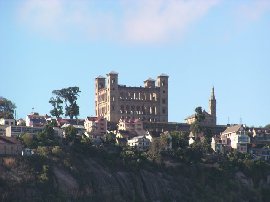 |
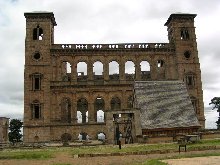 |
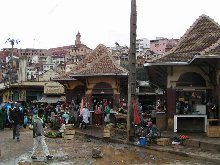 |
|
| Tana | The Rova from afar | The ruined Rova | Tana Market |
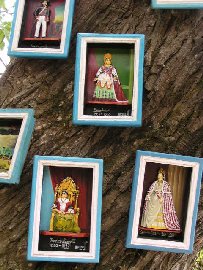 |
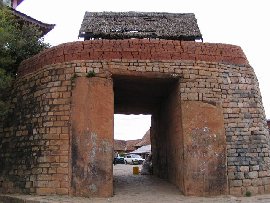 |
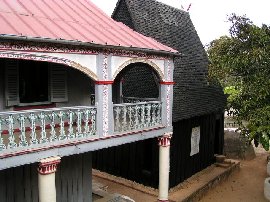 |
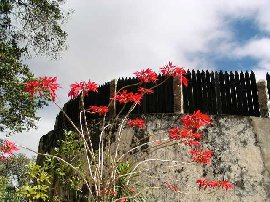 |
| Portraits of Malagasy monarchs | Ambohimanga - Gate | The Rova at Ambohimanga | The Rova at Ambohimanga |
Madagascar:
Erotic Tombs, Tribal Warriors & Bull Fights In The Great Red Island
Madagascar, the world’s fourth
greatest island at over 1600 km long and 570 km wide, is also known as the Great
Red Island due to the red soil found there.
Due to serious deforestation, and tavy, which is slash and burn farming,
Madagascar’s red soil is increasingly being exposed and eroded.
The red soil is washed into the rivers, which stain them blood red, and
this in turn is carried to the ocean. You
only need to fly over the island to see how red the whole place is.
Thus, the environmental degradation of Madagascar gives a whole new
meaning to this expression.
Madagascar
is a land with unique fauna and flora, and that is a function of its isolation.
This land was once part of the great island, Gondwana, which included
Africa, India, Australia and South America 250 million years ago.
As Gondwana splits apart due to volcanic activity and continental drifts,
the various continents were formed, and Madagascar came into being as it split
off as a separate land mass 65 million years ago.
As
a result of its relative isolation and the late arrival of mankind to the island
only 2000 years ago, Madagascar’s wildlife had been able to evolve
independently from those of the other continents and acquire characteristics
which are unique. This is what
makes this island special in the eyes of scientists and animal lovers.
However, as we were to discover later, the unique natural heritage of
Madagascar is rapidly disappearing, as its human population continues to grow
and uncontrolled and unplanned agricultural activity is destroying the
island’s surface cover. I am
pessimistic about the protection of Madagascar’s wildlife.
I am not surprised if I ever return to this land, most of the wildlife I
have seen on this trip will only be seen in the zoo and nowhere else.
----
We
arrived in the evening at the airport of the capital, Antananarivo – what a
mouthful of a name! That is
something we were to discover in Madagascar. Pronouncing Malagasy names can be a
tongue-twisting exercise. Try the
name of the country’s greatest kings – Andrianampoinimerina – and even
that is the short for Andrianampoinimerinandriantsimitoviaminandriampanjaka.
Fortunately, the capital does have a shorter alternative, Tana.
Malagasy
bureaucrats are world renowned for their super-efficiency that even the Swiss
have to take their hats off. Given
that there was only one flight arriving, the fact that it took us more than an
hour and a half to clear Malagasy passport control was testimony to the
efficiency here. All foreigners
needed visas to enter and all had to queue up to pay for visa stamps.
Then next you queue to get your passports checked.
Each visitor has the honour of having his passport checked by at least
four officers each of whom must sign and counter sign the passport and other
slips of paper floating around the passport control box – what a perfectionist
system of internal control to ensure checks and counter-checks to prevent
corruption and infiltration of international terrorists.
Madagascar is doing its part of the War Against Terrorism!
Once
we cleared passport controls and customs check – we saw Malagasy people been
examined with their luggage opened but fortunately foreigners were spared – we
were set upon by thirty people offering us taxi transfer, money exchange, porter
services and god-knows-what services. What
sweet people, each shouting and screaming at the top of their voices and some
grabbing our luggage and threatening to tear our limbs apart.
“Hang
on, hands off, HANDS OFF!” We have to shout to prevent us from been mutilated
and cut to pieces. “We have
people picking us up!”
That
dissuaded the taxi drivers but others continued to hassle us.
“Get away! Get away!”
I
asked around for the guys from Hotel Sakamanga, which agreed via email to pick
us up while E. proceeded to change some euros into Malagasy Francs, though not
before beating off some black marketers.
Money
changed but the Sakamanga guys were nowhere to be seen.
So I negotiated with a guy offering to drive us to town for FMG 50,000
(about US$7). Fine, but I found six
people following us to the car, some symbolically giving us a hand by holding on
to a strap or two of my backpack. And
as we placed our stuff into the run-down car, which would have gone to the scrap
yard if it was in Singapore, a few guys asked for money for having “helped”
us with the luggage.
“No
way, no way. We carried our own
stuff – none of you helped us!” Ridiculous!
“Get Away!”
In
the meantime, E. was arguing with another chap who insisted that E. should
change money with him. When E. said
he had already changed his money, that guy said that E. was lying because he
wouldn’t have changed money in such a short time.
“Let’s
go! Let’s go.” I told the driver as four or five pairs of hands were still
holding on to the car door, with their ridiculous demand for our money,
patronage and whatever. And so off
we go.
Fifty
meters down the road, and I shouted at the driver, “Can we stop now?
I need to check our luggage in the boot.” I was worried about the mass
of people around the car and wondered if our luggage was intact.
I got out of the car and checked that everything was okay.
At
this point, a man walked over and waved a license-like card, “I’m the
official airport taxi. You are not
allowed to take illegal transport.”
Our
driver shouted, “Get in the car! Quick!” I jumped into the car and slammed
the car door. Then the driver sped away as fast as he could, into the dark,
unlit roads. I asked myself, where
the hell are we going? If he
decides to kill and rob us, there is nothing we can do.
Forty minutes later, we found ourselves at Hotel Sakamanga. “Welcome to Madagascar!”
----
The
origin of the Malagasy people is a mystery for historians and anthropologists.
Anthropological and linguistic evidence suggests that the Malagasy people
were the descendants of mariners from Indonesia who came here 1500 to 2000 years
ago, and the admixture of these immigrants with Bantu people who moved over from
Africa across the Mozambique Channel. Linguists
place the Malagasy language as among the Malay-Polynesian family of languages
and say that it is closest to a tribal language in Borneo, although no one knew
how or why did they sail so far across the Indian Ocean to Madagascar.
Indeed, when we listened to Malagasy music, we have found it sounding
amazingly similar to Malay or Indonesian, although it is more difficult to find
any perfect match of words. The facial features of the Malagasy people, especially those
living in the Highlands, also resemble those of Indonesia.
Walking around Tana, we often thought we were in Downtown Jakarta.
In addition, Malagasy also eat rice as a staple, like the Indonesians,
and most unlike their African neighbours who tend to eat cassava and other tuber
roots. In fact, the Malagasy eat
more rice per capita than any other nation in the world.
----
Tana.
Capital of Madagascar. The city was
founded in 1610 by King Adrianjaka of the Merina people, the most
Indonesian-looking of the eighteen Malagasy tribes.
He placed a garrison of a thousand men here and called the city
Antananarivo, meaning Town of the Thousand.
On top of a hill, he built a Rova, or palace.
The capital was moved here by King Andrianampoinimerina at the end of the
18th century from Ambohimanga 20km to the north.
From here, his son and successor, King Radama I, went on to conquer all
of Madagascar so that his kingdom would have no frontier but the sea.
The French came and too ruled the colony from the city, which lies near
the geographical centre of the island.
The
impressive European-style Rova, also known as the Queen’s Palace on account
that most of Madagascar’s 19th century monarchs were female, sits
on the top of a hill – one of the twelve on which the city was built on –
overlooking the city and pretty Lake Anosy.
This used to be the heart of the old Kingdom of Madagascar, the focal
point of attention of the nation and its capital.
Queen Ranavalona I was renowned for dropping her less favoured subjects
off the cliffs from here. The Rova
was also the resting place of the monarchs whose tombs were venerated for good
harvest and fortune.
On
6 November 1995, an arsonist burned down the entire Rova including the royal
tombs in an attack that destroyed one of the most important treasures and
historical heritage of the Malagasy people and nation.
80% of the historical artefacts, antiques and historical documents within
the complex were destroyed. For the
people of Madagascar, for whom ancestral worship and veneration of the remains
of the dead are important, the destruction of the royal tombs is spiritual as
well. The soul of the nation was
burned to ashes. Today, only the
facades of the Rova remain. A slow
process of reconstruction is continuing and a museum nearby displays the
artefacts which had been rescued.
We
visited the ruins of the Rova and the museum.
There were a number of old photos of the Malagasy royalty in western
court dress as well as exchange of letters with Queen Victoria of the British
Empire, with whom the Malagasy monarchy maintained close contact till the
invasion and abolition of the Malagasy state by the French in 1896.
Like
Thailand and Ethiopia, Madagascar woke up to the reality of European expansion
in the 19th century. Malagasy
monarchs realised that without modernisation and international diplomacy, the
nation would soon be doomed like many of its neighbours in Africa. It acquired the trappings of a modern state, such as
adaptation of western court attire and protocol, building of western style
palaces, setting up of modern administrative structures and modernisation of the
army.
Like
Thailand and Ethiopia, Malagasy monarchs also faced enormous internal opposition
towards reforms. However, in the
case of Madagascar, its monarchs were not powerful enough to overcome
conservative opposition, and a few kings and queens were assassinated by their
enemies. Through a mixture of
domestic reforms and international diplomacy, Thailand and Ethiopia were able to
remain independent. Madagascar,
however, eventually succumbed to international intrigue. By the 1890’s, the British, who had enormous interest in
Madagascar, agreed to trade Madagascar for Zanzibar, thus allowing the French to
march in and abolished the monarchy in 1896, with the last queen, Ranvalona III,
exiled to Algeria.
The
Rova today, is nothing but a ghost of its past.
The Malagasy nation never seems to have recovered from its decline.
The great blow was dealt when the arsonist’s torch destroyed the last
remnants of its royal past. The cold winter winds howled as though the ghosts of the dead
monarchs were crying over the loss of the palace and the state of the nation.
The Malagasy flag fluttered with a mix of bright red, white and green.
Maybe there is hope after all.
----
In
the mid 1980’s, Chinese martial arts, or Kungfu, became very popular in
Madagascar and Kungfu associations soon developed into paramilitary groups in a
bizarre episode of Malagasy history. In
late 1984, President Ratsiraka banned the practise of Kungfu as Kungfu
associations emerged as rival centres of power.
In Dec 1984, clashes broke out between Kungfu associations and
presidential guards. Clashes
continued until July 1986 when army units backed by armoured cars and
helicopters finally destroyed the HQ of the Kungfu groups, killing its leader
and 200 followers, thus ended the Kungfu threat to the state once and for all.
----
Tana
is now a city of 2 million people. Its
streets are dirty, narrow and crowded with vehicles, not to count the numerous
hawkers selling newspapers, batteries, snacks and god-knows-what to those caught
in the jam. It is chaotic,
unplanned and simply bloody messy. The
streets looked as though they have never been widened since the French left in
1960. Two-to-three storey buildings
share downtown city blocks with rice paddy fields and vegetable gardens.
The exodus of the landless rural to the city have enlarged the city way
beyond what its original planners had intended.
Typically Third World disaster scenario.
Madagascar
is a terribly mismanaged country. Since
independence in 1960, the country had gone through coups, uprising and general
chaos, not to mention nearly two decades of gross misrule by a former admiral
who first destroyed the economy by turning socialist – President Ratsiraka
even wrote his own little red book – and then turned dramatically to
capitalism, i.e., the crony and corrupt kind that excluded real free markets,
accountability and checks and balances.
The
result? Madagascar is the 7th
poorest country in the world. In a survey of 175 countries, Madagascar ranks 149th
in human development index. Life
expectancy is only 53 and only 35% of the population had completed primary
education. Everywhere we witnessed
extreme poverty although we saw relatively little begging compared to other
developing countries. There were,
however, many street children and homeless people. We walked past a market one evening and suddenly realised
what we thought were mere plastic sheets of rubbish on the ground were actually
homeless people sleeping under multiple layers of rags and plastic sheets.
This was the height of winter and it must be really freezing living in
such conditions. It is bad enough
to be poor, but it is certainly worse being poor in a cold country.
In
addition, Madagascar has the dubious reputation of being the 3rd most
corrupt country in the world, behind Bangladesh and Nigeria, and sharing its
ranking with Paraguay and Angola. Many
times on this journey, the driver we engaged were asked for bribes by corrupt
police at numerous checkpoints. Even
as we departed the country at Tana airport, various uniformed officers asked for
money with casualness that underline how ingrained corruption is in this
country.
It
is no wonder that a BBC correspondent once wrote:
“Madagascar
is a land of tremendous potential. It always will be. There's an inertia here, logistical and economic problems
that its almost impossible to see anyone taking control over.”
![]() Send
your comments to Tan Wee Cheng, Singapore
Send
your comments to Tan Wee Cheng, Singapore
![]() Back to Homepage of CHASING THE INDRI
Back to Homepage of CHASING THE INDRI
![]() Back to the Main Homepage of Weecheng.com
Back to the Main Homepage of Weecheng.com